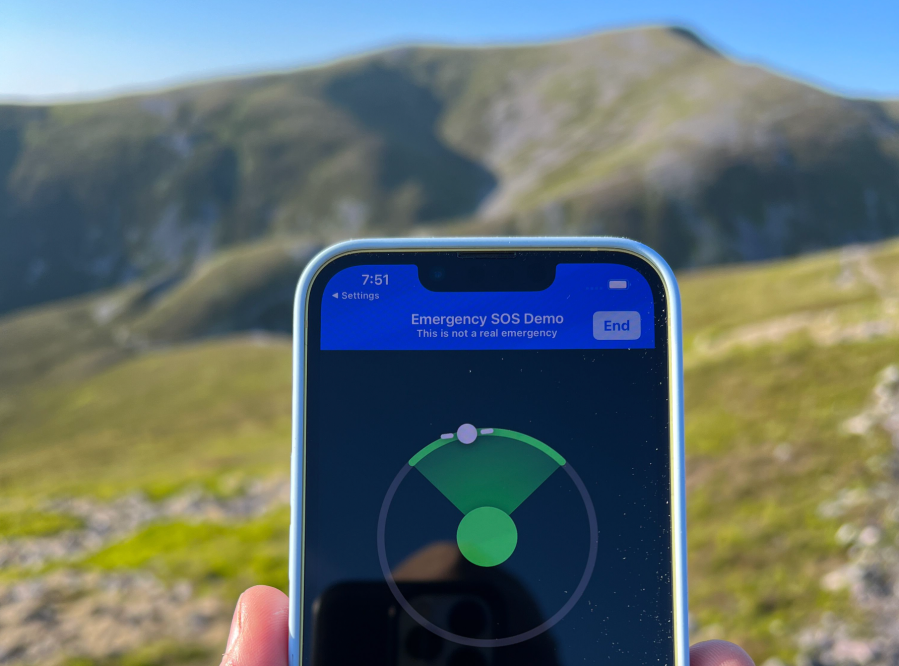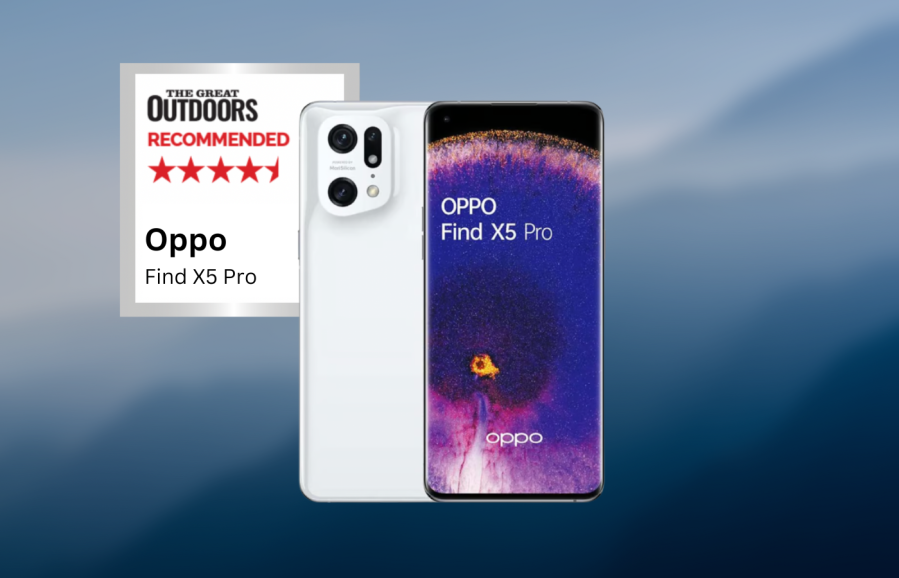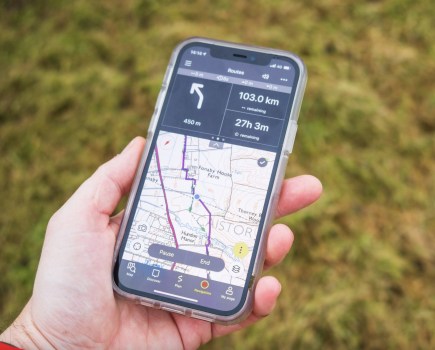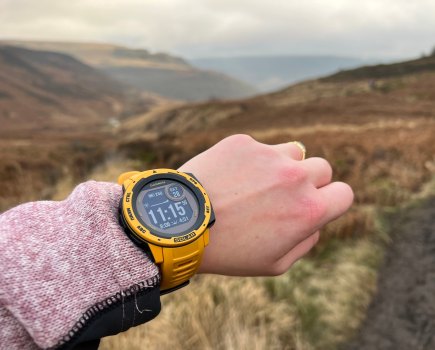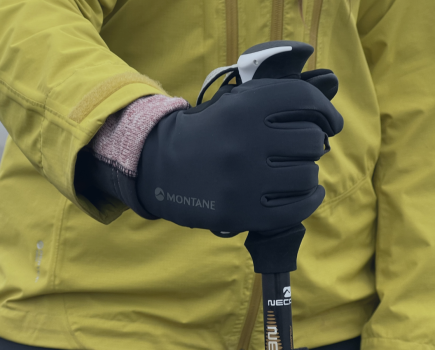From taking photos and navigation to sharing your adventures through social media, phones can do a lot for us in the great outdoors – although it’s up to us to decide how connected we want to be. Simpler apps like OS Locate can add a surprisingly large margin of safety. Mapping apps are convenient and quick to use when navigating. And even if you don’t Instagram every step of your hike, there’s satisfaction in posting a picture or two for others to enjoy. But can the phone you carry in your pocket the rest of the time also perform in the mountains? Well, the best smartphones for the outdoors – and those not necessarily designed for these environments – can offer features which will make you life out there a lot easier.
Main image: the iPhone 14 acquiring satellites | Credit: Alex Roddie
Now that most phones are waterproof and have long battery life, it’s arguable that the dedicated rugged outdoor phone – such as the Motorola Defy Rugged Smartphone first reviewed by Chris Townsend in 2021 – is less important than it once was. A regular phone with tough case and screen protector will stand up to general mountain use, and conserving power (keeping the phone in airplane mode when out of signal, for example) can extend battery life for several days. A power bank can extend battery life even further for long-distance backpacking.
However, most phones have a screen that will crack or smash when dropped on a rock – Gorilla Glass can only do so much. And many phones also have a glass back to enable wireless charging, making it even more fragile. For ultimate peace of mind, or if you often drop your phone, it’s worth considering a ruggedised model that doesn’t need a case.
Considering a flip or folding phone? At the time of writing (first published in the September 2023 issue of The Great Outdoors) this tech is relatively new, and phones with folding glass screens are much less durable. In another year or two the technology may have caught up, but for now stick to a traditional slab design for mountain use.
Let’s dive into the reviews of the best smartphones for the outdoors – as well as the features to look for when making your selection.
The best smartphones for the outdoors in 2024
Testing conditions
Our tech expert, Alex Roddie tested these phones on a variety of day hikes and short backpacking routes in the Scottish Highlands throughout spring and summer 2023. Weights stated are as measured on Alex’s digital scale. He is an iPhone user but has extensive experience with Android devices over more than a decade.
Further reviews of the OPPO smartphones for the outdoors were conducted by Chris Townsend in late 2022 and early 2023.
- Nokia XR21 | Best buy | £499
- Apple iPhone 14 | Recommended | £849
- Oppo Find X5 Pro | Recommended | £1049
- Cat S75 | £549
- OPPO Reno 8 | £599
Nokia XR21 – BEST BUY – smartphones for the outdoors
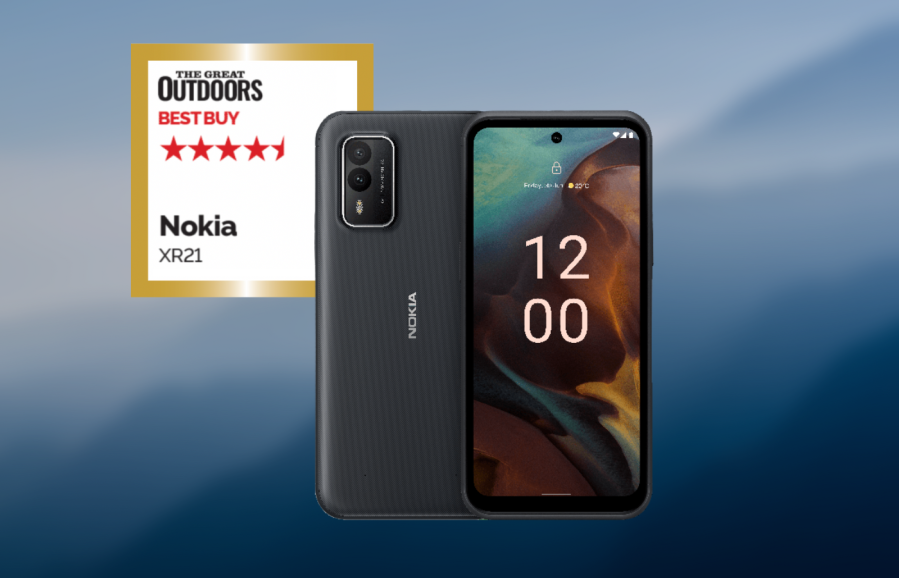
Alex Roddie’s Best in test
Overall, for Android users who go into the mountains the XR21 is a fantastic choice. If you don’t need the highest specs available, this is one of the better rugged phones you can buy.- Highly durable
- Good camera quality
- Bright screen that can be used with gloves
- Good value
- Longevity
- No telephoto camera
- Storage limited to 128GB
| Quick specs | |
|---|---|
| RRP: £499 Weight: 230g Size: 168 x 78.58 x 10.45mm Screen: 6.49” IPS LCD, 406ppi pixel density, 120Hz refresh rate Materials: Gorilla Glass Victus screen, impact-protected polycarbonate frame with TPU bumpers, 100% recycled aluminium inner chassis Operating system: Android 12 Storage: 128GB (non-expandable), 6GB RAM Battery: 4,800mAh Cameras: 64MP f/1.8 (wide), 8MP f/2.2 (ultrawide), 16MP f/2.4 (selfie) Features: USB-C port, face/fingerprint unlock, 2x customisable buttons, IP68/IP69K dust/water resistant, 1.8m drop resistant, MIL-STD-810H compliant, 33W fast charging |
Nokia has a reputation for making reliable mid-range all-rounders rather than flagship phones packed with the very best technology, and the new XR21 fits this description. Specs and price are both mid-range, but depending on your priorities you actually get a lot for your money here (it’s the most affordable device tested). The main compromise is the 128GB of built-in storage with no upgrade options. This will be enough for most people, but if you need to store a lot of offline music, video, or even mapping data then you could exceed this. I found performance to be excellent in general use, with no slowdowns or lags.
Overall, for Android users who go into the mountains the XR21 is a fantastic choice. If you don’t need the highest specs available, this is one of the better rugged phones you can buy and is likely to keep performing for several years. It’s excellent value.
Read Alex’s full Nokia XR21 review.
Oppo Find X5 Pro
Chris Townsend Recommends
- Camera quality
- 5-axis image stabilisation
- Waterproof
- Dustproof
- Large battery
- Limited telephoto lens
- No micro SD slot
- Slippery back
- Expensive
| Quick specs | |
|---|---|
| RRP: £1049 Weight: 223g Pros: Camera quality, 5-axis image stabilisation, waterproof, dustproof, large battery Cons: Limited telephoto lens, no micro SD slot, slippery back, expensive Size: 163 x 74 x 8.5mm Operating system: Android 12 Storage: 256GB Battery: 5000 mAh Cameras: Rear: 50mp f1.7 main, 50mp f2.2 ultra-wide angle, 13mp f2.4 telephoto; front: 32mp f2.4 |
The Oppo Find X5 Pro was supplied for test on the basis that it has 5-axis stabilisation for shooting steady video and still photographs rather than as an actual phone. Oppo says this is “the industry’s first mobile device with SLR Level stabilisation”. To find out just how good it is as a camera, and how suitable it is for outdoor use, Chris Townsend took the Find X5 Pro out on walks over a period of five months. He took well over 300 photographs and shot half a dozen short videos in every sort of weather and lighting conditions. He also used it for navigation, posting to social media, checking web sites (mainly weather forecasts), reading e-books, and even as a phone. It does all of these fine.
Video is when the five-axis stabilisation really shows its worth. Chris took handheld videos while standing still and moving and they look fine on my computer monitor. As with the still cameras there are many options and it’s worth experimenting to get results you’re happy with. Again, the quality of videos is better than the mid-range phones he’s used and more comparable with his camera.
The Find X5 Pro is a fine phone camera, especially for wide and extra wide-angle images. The limited telephoto is disappointing though. The camera is tough and suitable for rough outdoor usage. He didn’t treat it gently. If you want good quality photos from a phone it’s certainly worth considering. However, while you can just use the Find X5 Pro as an automatic point-and-shoot he think this is a waste of its capabilities. To get the most from it you need to delve into the various options and learn how to use them. This takes time but is well worth while.
Read Chris’ full review of the Oppo Find X5 Pro here.
Apple iPhone 14 – RECOMMENDED – lightest smartphone for the outdoors
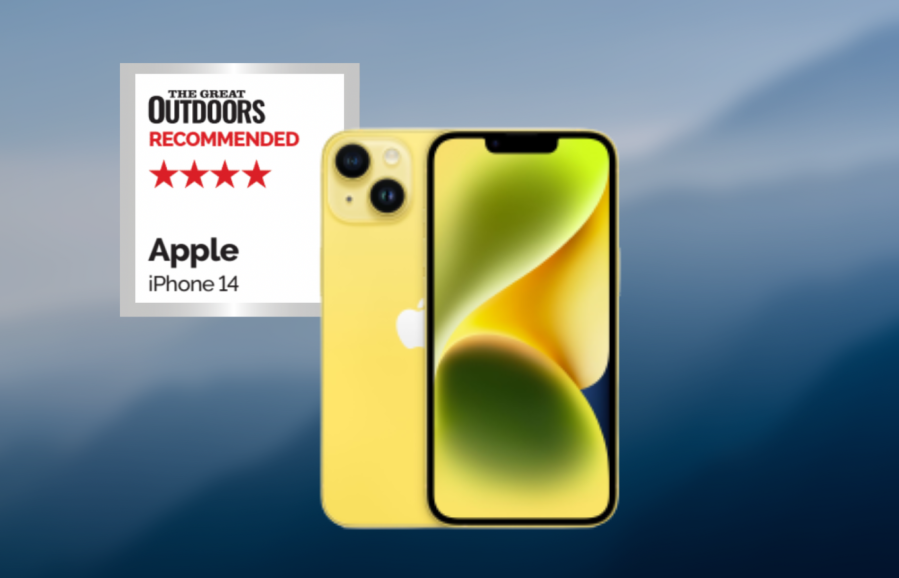
TGO Magazine verdict
- Extremely fast and fluid
- High build quality
- Unmatched app quality and ecosystem
- Sharp screen
- Thin and light
- Expensive
- No telephoto camera
- Garish camer colours
- Requires case
- No programmable buttons
| Quick specs | |
|---|---|
| Price: £849 Weight: 169g Size: 146.7 x 71.5 x 7.8mm Screen: 6.1” OLED, 460ppi pixel density, 60Hz refresh rate Materials: Toughened glass screen and back with Ceramic Shield, aluminium frame Operating system: iOS 16 | Storage: 128–512GB storage (non-expandable), 6GB RAM Battery: 3,279mAh | Cameras: 12MP f/1.5 (wide), 12MP f/2.4 (ultrawide), 12MP f/1.9 (selfie) Features: Lightning port, face unlock, satellite comms (SOS and Find My only), IP68 dust/water resistant, 15W fast charging, MagSafe wireless charging |
The iPhone 14 was released in September 2022, and is almost identical to the iPhone 13: more RAM (6GB vs 4GB), a fractionally faster processor (which remains industry-leading), and about an hour more battery life. It’s a compact, lightweight phone made from high-quality aluminium and glass. Although marketed as Ceramic Shield, and claimed to be crack resistant, it’s still slippery glass and I wouldn’t use this phone on the hill without a durable case and screen protector. On the plus side, it’s waterproof. There are no user-programmable hardware buttons.
While the price is high, and there are few meaningful upgrades over last year’s iPhone 13, the satellite functionality is a welcome addition – and could even save your life. If you’re already an iPhone user with a phone more than three or four years old, this is a worthy upgrade. If your phone is newer, there’s no substantial reason to get the 14.
Read Alex’s full Apple iPhone 14 review.
Cat S75
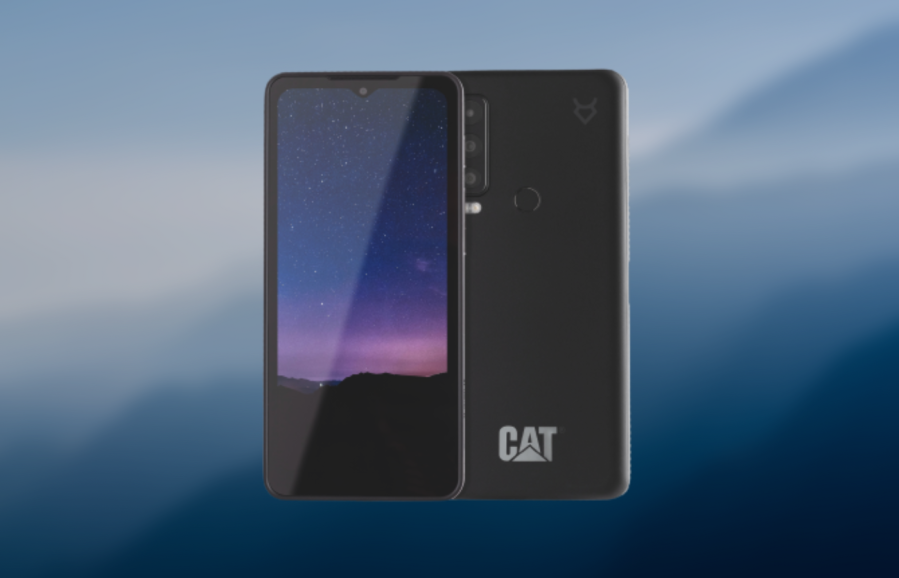
Alex Roddie’s verdict
Built-in satellite messaging is the main standout feature of the Cat S75, which is otherwise a bulkier and less capable device than the others tested.- Highly durable
- Affordable satellite texting
- Expandable storage
- Big and heavy
- Poor camera
- Power button placement
- No android 13
| Quick specs | |
|---|---|
| Price: £549 Weight: 268g Size: 171 x 80 x 11.9mm Screen: 6.6” IPS LCD, 400ppi pixel density, 120Hz refresh rate Materials: Gorrilla Glass Victus screen, polycarbonate and TPU frame Operating system: Android 12 Storage: 128GB storage, Micro SD card slot, 6GB RAM Battery: 5,000mAh | Cameras: 50MP f/1.8 (wide), 8MP f/2.2 (ultrawide), 2MP f/2.4 (macro), 8MP f/2 (selfie) Features: USB-C port, face/fingerprint unlock, satellite comms (SOS & texting), 2x customisable buttons, IP68/IP69 dust/water resistant, 1.8m drop resistant, MIL-STD-810H compliant, 15W fast charging, wireless charging www.catphones.com/en-gb |
This is a chunky device: bigger and heavier than the others tested, making it difficult to use with one hand (a problem made worse by the inconvenient location of the power button). However, some of the thickness can be explained by the satellite communication hardware. Construction is solid but doesn’t feel as premium as the Nokia or iPhone. The plastic outer shell is also smooth in the hand. There are two programmable buttons and the choice between a second SIM and Micro SD storage expansion. However, if you want to use the satellite features then this requires a separate SIM card, blocking the Micro SD slot. There’s also a rear-mounted fingerprint sensor that I found reliable.
Built-in satellite messaging is the main standout feature of the Cat S75, which is otherwise a bulkier and less capable device than the others tested. It’s a competent outdoor smartphone, though, and if planning an expedition to somewhere remote then this could be a useful one-device solution.
Read Alex’s full Cat S75 review.
OPPO Reno 8 Pro

Chris Townsend’s verdict
The lightweight Reno 8 Pro is a good but limited phone camera with two good lenses and two not so good. For video it’s fine. It’s not as tough as Chris would like for a hillwalking camera though.- Good main & selfie camera
- Video stabilisation
- Large battery
- Quite light
- only IP 54 rating
- no telephoto lens
- no micro SD slot
| Quick specs | |
|---|---|
| RRP: £599 Weight: 185g Size: 161 x 74.2 x 7.3mm Operating system: Android Memory: 256GB Battery: 4500 mAh Cameras: rear: main 50mp 23mm f1.8, ultra-wide angle 16mm 8mp f2.2, macro 2mp f2.4, front: 22mm 32mp f2.4 |
Oppo asked Chris Townsed to try the lower spec and lower cost Oppo Reno 8 Pro. The phone was supplied for review as a camera and described as “tailor-made for lowlight photography, perfect for snapping nature, trails, and memories on your outdoor activities, whatever the weather” so his review is based on how it performs as a camera and a phone for the outdoors.
Chris used the Reno 8 Pro for two months on low- and high-level walks in the Cairngorms during which he took hundreds of photographs and shot half a dozen videos in every sort of weather and lighting conditions. He also used it for navigation, posting to social media, checking websites (mainly weather forecasts), reading e-books, and even as a phone. It does all of these fine.
The lightweight Reno 8 Pro is a good but limited phone camera with two good lenses and two not so good. For video it’s fine. It’s not as tough as Chris would like for a hillwalking camera though. This isn’t a rugged phone. The heavier Find X5 Pro is much tougher and also better as a camera. But it does cost almost twice as much. However, there are phones that cost considerably less that are tougher, and have adequate cameras.
Read Chris’ full review of the Oppo Reno 8 Pro here.
Features to look for in the best smartphones for the outdoors
Cameras
Most phones now have at least two camera lenses, offering a variety of focal lengths. If you prefer zoomed-in shots, look for a telephoto lens. Megapixels aren’t everything; also consider sharpness and colour accuracy.
Screen
Bigger screens display more content (great for mapping apps) but increase size, weight, and expense, and can reduce battery life. Brighter screens are easier to use in direct sunlight. Also consider sharpness, measured in PPI; more is better. A refresh rate above 90Hz will make animations appear more fluid.
Ruggedness
Every phone tested is waterproof and dust resistant. Look for a rating of at least IP67 for mountain use. Shatter-resistant glass can still easily be damaged by dropping onto a rock, so unless the phone is also drop tested, add a tough case and screen protector.
Battery life
Battery life varies based on use and many other factors. More capacity (in mAh) is generally better, but it doesn’t always translate into longer battery life.
Storage
Most phones no longer allow expandable storage; make sure it comes with enough. 128GB is a realistic minimum.
Operating system
iPhones run iOS; every other phone runs Android. Both have their pros and cons, and personal preference is now the deciding factor. If you have other Apple devices, then an iPhone offers greater integration.
Additional features
Features to look for in an outdoor phone include a choice between face/fingerprint security (useful if wearing gloves), customisable shortcut buttons, quick access to camera, and a USB-C port for compatibility with other devices. Fast charging is also useful.
Size and weight
Many phones now weigh over 200g. In addition to screen size, materials are a factor, with stainless steel and glass adding weight to some premium devices. Aluminium and plastic are lighter.
Satellite comms
Some devices have built-in satellite hardware, enabling communications without phone signal. This may be limited to emergency SOS, or may include texting. Satellite features usually require an additional subscription – and will not cover every feature offered by dedicated devices such as an inReach or SPOT.
Audio
None of the phones tested come with a 3.5mm audio jack; you will need to use wireless or USB-C/Lightning headphones, depending on device.
Read more: The best hiking backpacks of 2023

